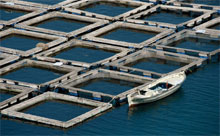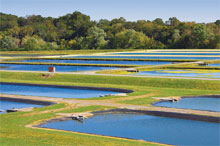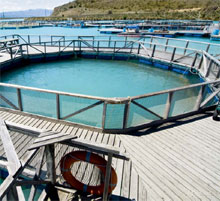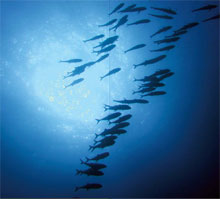Aquaculture Insurance The Need for Evaluation of Disease Risk for the Sustainability of a CompanyAGRICULTURAL
Victoria Alday. D.V.M. University of Zaragoza, Spain M.Sc., Ph.D. University of Stirling, UK
Aquaculture is the fastest growing food-producing sector, increasing its overall global output by about 10% annually for the last two decades. It currently accounts for almost 50% of the world’s seafood, and it is widely agreed that has the greatest potential to meet the growing demand for aquatic foods (figure 1).

Table 1. Contribution of aquaculture to food-fish supply
Given the projected population growth, it is estimated that aquaculture will produce 85 million tones of aquatic food by 2030, an increase of 34 million tons over the 2006 level (Food and Agriculture Organization of the United Nations, 2006). This means that that by 2030, there will be more fish for direct human consumption from aquaculture than captured fish, Aquaculture clearly has an important role filling the gap between sustainable wild fisheries supplies and the growing seafood demand.
Disease is understood as a production cost so proper sanitary management is crucial to a sustainable and profitable business
Diseases in Aquaculture
Diseases are a constant if not altogether routine aspect of livestock rearing and as such we often find them in aquaculture. Aquaculture has gone through an intense learning experience in a very short period of time. Over 300 different species are cultured, under a wide range of environmental conditions. This requires the optimization the environmental conditions, nutritional requirements, identification of pathogens and implementations of disease prevention measures. Once the culture conditions have been set, health becomes a measure of productivity. In other words, disease is understood as a production cost and therefore proper sanitary management is crucial to a sustainable and profitable business.
Losses due to diseases can be divided in two main groups. Firstly the ones due to acute mortality or caused, often, by known pathogens and secondly those caused by poor survival, often not understood but still expected. Precise per annum figures of consequences of disease losses are difficult to pin-down, but some estimates are available (Table 1). These figures have been obtained during periods when the industry was affected by acute epidemics, mainly due to viral diseases. However, losses due to chronic diseases, poor survival and low performance are not considered as a disease problem but a production cost. The cost of these types of diseases is likely to surpass the cost of the acute ones. A global estimate of disease losses to aquaculture by the World Bank in 1997 was in the range of USD 3 billion per annum. Minimizing these losses is one of the key factors for a sustainable business.
| Region | Disease | Years | Estimated Losses (USD) |
|---|---|---|---|
| Asia | Epizootic Ulcerative Syndrome | Before 1990 | Over 10 million |
| Western Europe | Viral Haemorrhagic Septicaemia Virus | Annually | 60 million |
| China | White Spot Syndrome Virus | 1993 | 250 millones |
| India | White Spot Syndrome Virus | 1994-1995 | 17,6 milloness |
| Malaysia | White Spot Syndrome Virus | 1995-1999 | 25 million/year |
| Bangladesh | White Spot Syndrome Virus | 1995 | 10 million |
| Thailand | White Spot Syndrome Virus | 1996 | 210-250 million |
| 1997 | 600 million | ||
| Ecuador | White Spot Syndrome Virus | 1999 | 280,5 million |
| 2000 | 400 million |
Assessing Risk of Disease
As mentioned before, diseases are part of any animal production system. Reducing their presence or their impact is part of a risk management strategy that would take into account the present health status of the animals in the facility and neighboring area, the technical level of the on-farm staff, the legislative frame of the country and region, its diagnostic capacity and access to health management expertise, and the biosecurity plan for each facility. Table 2 refers to each of these parameters in detail and provides a score system in an attempt to quantify the relative importance of each of them.
| Issues | Scope | Posible score |
|---|---|---|
| 1 Present health status of the facility | Presence and type of primary pathogens. Possibility of treatment or vaccination. Diseases caused by opportunistic pathogens would imply poor health management. | 0-5 |
| 2 Disease records of the last 2 years | 0-10 | |
| 3 Capabilities of on-farm staff | Capacity to spot possible and potential health problems. Field diagnostic kits on site. | 0-5 |
| 4 Disease status of the neighboring farms and country | Check World Animal Health (OIE) and scientific and popular literature. | 0-3 |
| Marco legislativo | ||
| 5 National legislation on disease prevention and control | To prevent the introduction of pathogens into a country or their spread. | 0-10 |
| If not | ||
| 5.1 Restriction on the importation of live aquatic animals | Ban of importation from countries of lower sanitary status or request of health certificates . | 0-5 |
| 5.2 Regulation on the effluents and waste from aquatic animals processing plants | Avoid the release of pathogens into the natural environment and the posterior infection of farmed stocks. | 0-1 |
| 5.3 National reporting and isolation of infected facilities | Early warning system, isolation of infected facilities and national contingency plans. | 0-3 |
| 5.4 Existence of a National Diagnostic Reference Laboratory | As a support and control the quality of private laboratories. Updated on exotic and emerging diseases. | 0-1 |
| 6. Regional harmonization | Among neighboring countries to prevent the pathogen introduction. | 0-1 |
| 7 Facility under certification program | Although mostly focused on environmental, organic and social issues, they include good aquaculture practices. | 0-3 |
| Diagnostic capacity (available techniques) | ||
| 8. Histology based methods | Low sensitive technique for disease (endemic or exotic) outbreak diagnosis and detection of new pathologies. | 0-3 |
| 9. Polymerase Chain Reaction PCR (molecular methods) | Highly sensitive technique for known pathogens detection: surveillance and screening of broodstock and offspring. | 0-4 |
| 10. Evaluation of diagnostic quality | Operation under international standards, participation in ring tests, academic level of staff, regular calibration equipment. | 0-2 |
| Biosecurity | ||
| 11. External biosecurity | Presence of physical barriers, restriction of incoming vehicles and visitors, water filtration. | 0-3 |
| 12. Surveillance of wild animals | If sub-clinically infected, result in the transmission of pathogens to farmed animals. | 0-2 |
| 13. Introduction of live aquatic animals into the facility | The source of the animals (eggs, broodstock or larval stage) and health certificates need to be evaluated. | 0-2 |
| 14. Internal biosecurity | Health management program in place together with a contingency plan. | 0-4 |
| 15. Regular surveillance of farmed animals | Detect presence and increase of prevalence of pathogens forecasting possible epidemics. | 0-3 |
| Total score | 0-60 | |
Present health status of the facility and disease records of the last 2 years
Obviously, the present health status of the animals at the time of purchasing or renewing an insurance policy is of great importance, but the disease records of the previous two years are still more important. The expression of the disease of some pathogens is seasonal. They can either cause outbreaks during the cold weather -such as White Spot Virus in shrimp- or during the warm weather as Streptococcus in fish.
Pathogens can be classified as primary or secondary pathogens. The formers are those that can cause disease by themselves while the latter or so called “opportunistic pathogens” need to have an underlying situation (poor environmental conditions or a primary pathogen) to be able to cause disease. Primary pathogens that have not been detected within the last two years and have been under surveillance during that period of time may be considered absent or eradicated. Diseases caused by opportunistic pathogens require the investigation of the primary cause which often is related to poor health management of the animals. Once these conditions are corrected, the disease problem will disappear.
Not all pathogens have the same impact and not the same weight should be placed to combat each of them. Pathogens vary in terms of severity of the symptoms, including mortality and their means of transmission (particularly vertical transmission), possibility of exclusion, treatment or vaccination. Therefore, the detection of each specific pathogen in a facility should be evaluated in terms of risk to production.
Disease status of the country, legislative frame and regional harmonization
A well developed national legislation may prevent the introduction of pathogens into a country or their spread within the country. The new European Union Directive 2006/88/EC that was enforced in 2008 provides the most complete legislative frame for the protection of aquaculture production. Other countries are already working on the harmonization of their laws using the European one as the reference. It should always be taken into account that while having a suitable legislation is important, its implementation is crucial for its success. The degree of implementation of legislation varies greatly between countries and often, developing countries, where most of the aquaculture production takes place are deficient the resources for implementation.
The compulsory reporting of diseases outbreaks and the isolation of infected facilities may prevent further spread of the pathogen
An efficient legislation in terms of disease prevention and control needs to take into account four major issues.
- The restriction on the importation of live aquatic animals as the movement of live animals is the most efficient way of introducing pathogens. Apparently healthy animals may be carriers of pathogens that can be passed on to populations of different susceptibility. The ban on the importation from countries with lower sanitary status or the request of reliable health certificates may help to control the introduction. An example that proved the efficiency of such legislation was the introduction of WSSV disease in Philippines. In the early 90`s, the WSSV pandemia affected every shrimp producing country in South East Asia. Philippines reacted very quickly to the first WSSV outbreak in China by imposing a ban on the introduction of live shrimp. Such a measure prevented the introduction of the pathogen till 6 years later when live animals were illegally introduced into the country and together with the shrimp, the pathogen.
- Effluents and waste from aquatic animal processing plants need to be regulated to avoid the release of pathogens into the environment and later re-infection of farmed stocks. This is one of the hypotheses of the introduction of WSSV into America. Large amounts of frozen shrimp from Asia were introduced into Latin America for further processing and in the 90’s. Processing plants were placed near aquaculture production areas and solid wastes and effluents were released directly into the environment which is likely to have resulted in the release of the pathogen into the environment.
- The compulsory reporting of diseases outbreaks which are considered relevant for the industry and the isolation of infected facilities may prevent further spread of the pathogen and minimize the loss for the industry. The earlier this is done, the easier to control the spread of the disease.
- The existence of a national reference diagnostic laboratory will support private labs on the quality of their methodology and results and will be updated on exotic and emerging diseases that will facilitate a quicker response.
Having knowledge of the disease status of the country is also relevant due to the continuity of the aquatic bodies as pathogens do not recognize private properties or boundaries. Often, it is a matter of time that the disease problem of ¨the neighbor¨ becomes ours as well. The same happens with neighboring countries and the risk of disease transfer will depend on the type of pathogen and mode of transmission.
Certification schemes
There are a number of certification schemes to comply with certain production standards and product quality. Production standards (best management practices) deal mostly with sustainability, environmental and social impact (Global Aquaculture Alliance, GlobalGAP or WWF). Quality product programs deal mostly with organic labels (Naturland or IFOAM) and gourmet products (Label Rouge for France and UK; Guaranteed traditional specialty for Italy and Greece, or Thai Quality Shrimp).
It is now widely recognized that the implementation of better management practices in farming can bring significant improvement in production, reduction in the outbreaks of disease due to secondary pathogens and increased product quality. But none of these certification schemes specifically cover the area of disease prevention, and therefore complying with these programs do not insure reduction or minimization of losses due to diseases caused by primary pathogen, the ones responsible for catastrophic losses (i.e. such as the recent crisis of Infectious Salmon Anemia of salmon in Chile).
Diagnostic capacity
The diagnostic capacity of a farming facility - or its access to it - is of crucial importance for a speedy response to a disease outbreak. There are different techniques that vary on sensitivity and specificity and their application should depend of the purpose of the test. In the case of disease outbreak, low sensitivity test should be used such as histology that permits to confirm that the lesions are caused by the particular pathogen. In the case of screening or detection of pathogens in the absence of clinical signs, a highly sensitive method such as PCR is necessary to detect them. Evaluation of the quality of these diagnostic laboratories and procedures is highly relevant. There are some operating standards such as EN ISO/IEC, EN 45002 or EN 45003 that facilitate this task as well as the participation in ring tests.
Aquaculture insurance considers the present health status of the animals but the disease records of the previous two years are still more important
Diagnostic capacity
The diagnostic capacity of a farming facility - or its access to it - is of crucial importance for a speedy response to a disease outbreak. There are different techniques that vary on sensitivity and specificity and their application should depend of the purpose of the test. In the case of disease outbreak, low sensitivity test should be used such as histology that permits to confirm that the lesions are caused by the particular pathogen. In the case of screening or detection of pathogens in the absence of clinical signs, a highly sensitive method such as PCR is necessary to detect them. Evaluation of the quality of these diagnostic laboratories and procedures is highly relevant. There are some operating standards such as EN ISO/IEC, EN 45002 or EN 45003 that facilitate this task as well as the participation in ring tests.
Biosecurity of the facility
Biosecurity broadly describes the process and objective of managing biological risks in a holistic manner. Identification of the risks can be done from two perspectives, risk coming from the outside: bioexclusion (dealt with by external biosecurity) and risks spreading within the inside: biocontainment (dealt with by internal biosecurity). The principles of biosecurity can be applied to each of the different production species and systems whether they are intensive or extensive, but the implementation of biosecurity measures needs to be defined for each of these cases.
The main activities within external biosecurity involve the control in the introduction of live aquatic animals into the facility whether they are eggs, broodstock or larval stages. This is the most efficient route of pathogen introduction. Introductions should only be carried out after the acceptance of a reliable health certificate. The surveillance of the health status of wild animals from the surrounded areas may provide information on future risks faced by the facility. The effectiveness in the use of physical barriers, restriction of incoming vehicles and their disinfection, water filtration or recirculation or use of crab and birds fences need to be evaluated.
The main activities within internal biosecurity involve the active surveillance of farmed animals to determine their health status and possibly detecting emerging disease problems at different developmental stages. The compartmentalization of the production units together with restriction of staff movement and routine disinfection are examples of the control of spread of pathogens within the facilities.
As part of the biosecurity plan, each facility needs to have a contingency plan. The objective of a contingency plan is to recover the standard production in the minimum time, at the minimum cost and with minimum disruption after a disease outbreak. Short recovery and effective control is linked to rapid initial response and rapid, effective implementation of biosecurity measures
External biosecurity involves the control in the introduction of live aquatic animals into the facility whether they are eggs, broodstock or larval stages
Conclusions
Assessing the risk of disease would allow anticipating possible disease outbreaks and the subsequent production loss. It can also help to identify the weakness of the production system from the sanitary point of view.
Assessing the risk of disease and potential economic losses in an aquaculture facility is possible and necessary. By doing so, the insurance company can help the aquaculture facility to revise and often improve their health management strategy ensuring its sustainability.
Acknowledgement: The author wants to express her gratitude to Dr. Darryl Jory for the edition of this document.
Further information can be found at:
Global Aquaculture alliance
http://www.gaalliance.org/
Naturland
http://www.naturland.de
ISO-International Organization for Standardization
(Organización Internacional de Normalización)
http://www.iso.org
IFOAM-International Federation of Organic
Agriculture Movements (Federación Internacional
de Movimientos de Agricultura Orgánica)
http://www.ifoam.org
Organización de las Naciones Unidas para la
Agricultura y la Alimentación (FAO)
http://www.fao.org
GlobalGAP
http://www.globalgap.org
WWF - World Wildlife Fund (Fondo Mundial de la Vida Silvestre)
http://www.worldwildlife.org






